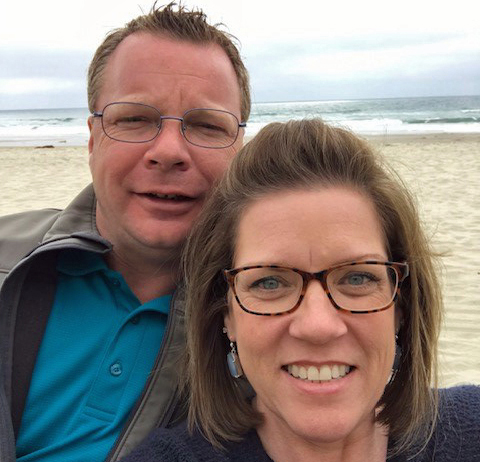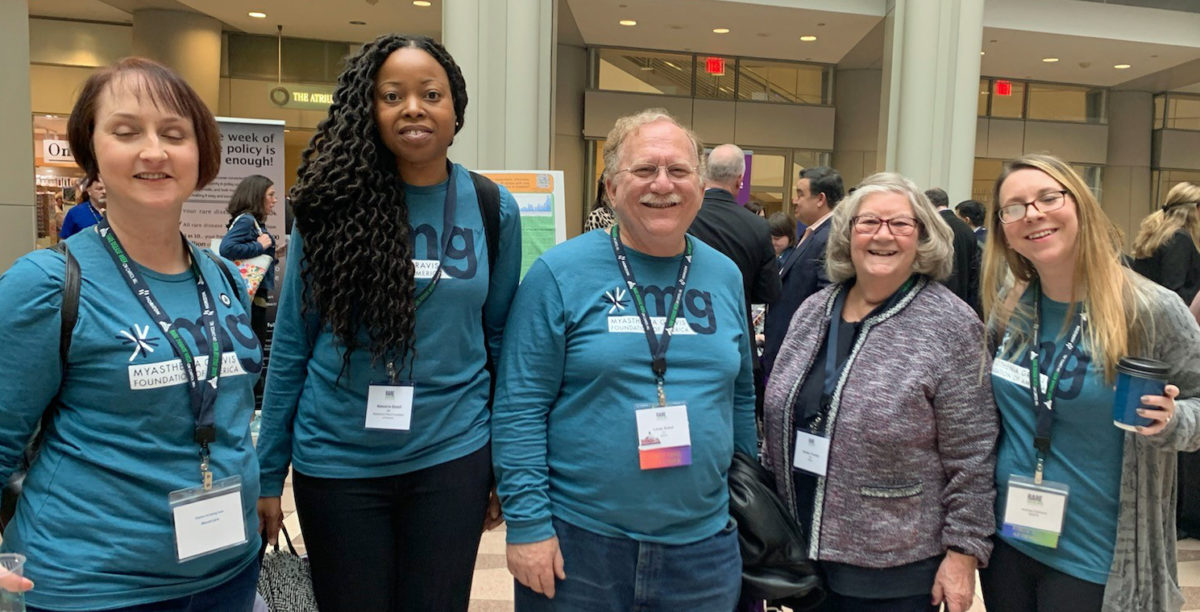Ten years ago, Karon Faught started slurring her words and having trouble lifting her arms to blow dry her hair. She was only in her thirties, but some months later while at work, she couldn’t find the right words she wanted to say. She thought she was having a stroke. An MRI disproved this possibility, but it did nothing to alleviate the overwhelming fear she and her husband Jerry felt about what was causing these symptoms.
When she went to her neurologist, he had a list of conditions he wanted to test her for. Among them was not myasthenia gravis (MG).
“He said he was going to test me for MS and ALS and a couple other things,” Karon recalls. But nobody gets myasthenia gravis, the neurologist said, so I’m not even going to test for that.
Ironically, MG was the thing Karon’s primary care provider specifically suggested she be tested for. Also ironically, while she was in the office, the neurologist agreed to give Karon a magnesium infusion, a treatment she’d had before to treat her chronic migraine headaches.
What Karon and Jerry didn’t know at the time was that magnesium is one of a laundry list of drugs that makes myasthenia symptoms worse. That infusion persuaded the neurologist to do the blood test, because there in his office, Karon lost her ability to speak and move as a result of it. Three weeks later, the tests came back positive for anti-acetylcholine receptor antibody-positive MG (AChR MG).
This was just the beginning of a harrowing ride for Karon and Jerry, one they are grateful to the MG community in their home state of Texas for helping them survive.
“Ten years ago, there was really no good information about MG,” Jerry says. “Even at the top hospital in the region, one of the only hospitals in the country that was doing an MG clinical trial, people didn’t understand it. Their nurses were still giving IV Benadryl to MG patients, and their medical school was still teaching that kids couldn’t get MG. When we came into this, the best knowledge base was those that came before us.”
So when Karon was facing surgery to remove her thymus (a procedure that is often part of treating MG), she wanted to talk with others who had the disease and could help her understand what to expect from this major chest surgery. She and Jerry attended their first Myasthenia Gravis Foundation of America (MGFA) national conference that year and connected with the only MG support group in Texas, which was in Lubbock, about 300 miles from their home north of Dallas.
The group was led by Coleen Shinn. She and others from the group took the couple under their wing. And when Karon was in the hospital after surgery, they were a lifeline for Jerry who guarded his wife’s treatment from healthcare professionals who repeatedly tried to treat Karon with medications on that laundry list of drugs that make MG worse.
“After my surgery, Jerry was on the phone with Coleen almost 24/7, asking her questions and gathering information,” Karon says. “When the doctors wanted to give me a medicine, he would call Coleen and say, is this okay? And she would say yes or no. A lot of times it was no, don’t give her that medication, because she’ll go into crisis.”
Jerry chokes up when he remembers this time. “I owe a huge debt of gratitude to Coleen and Marvin and Lowell and Margaret and all the people in Lubbock who took us in. There’s no way I can explain how they helped us. There are just no words that can describe it.”
After Karon’s surgery, she and Jerry continued to attend support group meetings in Lubbock. They needed that companionship and the knowledge of others who lived with MG. But it was a five-hour trek, and they knew there had to be other MG patients closer to home. So armed with contacts they met at their second MGFA conference, they pulled together a support group in the Dallas-Fort Worth area.
Since then, the couple has created a nonprofit support network, MG Texas, whose only mission is to empower people by sharing knowledge about this rare neuromuscular disease. The organization now supports honorary Texans all over the world, and through the work of many others, there are now support groups in Dallas, Lubbock, Austin, San Antonio, Corpus Christi, San Angelo, and Beaumont. And because they live only 20 miles from the Oklahoma border, it was easy enough to restart the groups in Oklahoma City and Tulsa after the MGFA reorganization. They’ve also started, MGKids.com, the only nationwide MG support organization for children with MG.
“There are so many fears when a person comes into this,” Jerry says. “If we can alleviate any one of those fears to help them get to the next stage of the healing cycle, then that’s really what drives us.”
This support group network has also been part of the healing cycle for Karon and Jerry.
“The support group has helped us get through this,” Karon says. “Helping other people has helped us heal from what we’ve lost. Having a diagnosis like MG, you have to look at life a little bit differently and make some adjustments. But when you help other people, you don’t think so much about what you’re going through.”
“I’ll be honest with you, at the beginning, I was angry, Jerry says. “And the only way to battle this disease that we can’t fight is to educate so that it doesn’t hurt others. That was the why we started the support group in Dallas. The bonus was, if we get more people in the group, it will help us.”
But healing the fear and anger is only a part of Jerry’s motivation.
“There’s a debt we have to pay forward,” Jerry says. “We’re going to have it for a long time. And that’s really what drives me.”


